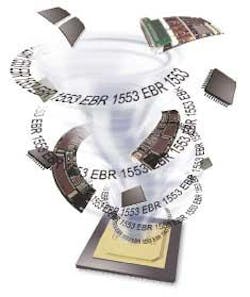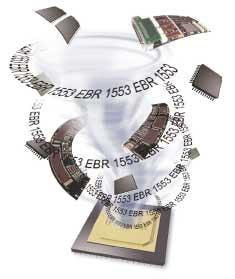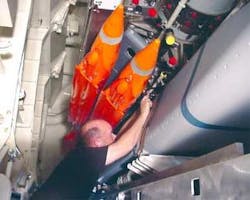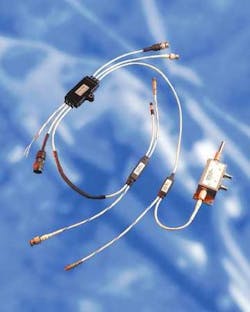Avionics designers plan for another decade with the 1553 databus
The old databus retains its stellar reputation for robustness and reliability, despite an onslaught of much faster competitors, and several alterations to the original bus to increase its bandwidth to speeds as fast as 500 megabits per second.
By Ben Ames
The MIL-STD 1553 databus has picked up a reputation over its 30-year career; actually, it has earned two reputations. Detractors call it heavy, expensive, and slow, while supporters say it delivers real-time determinism, low latency, and redundant channels.
The 1553 bus now sees a growing challenge from high-bandwidth demands of video, audio, and sensor data. Emerging databus standards can pass data through an aircraft hundreds or thousands of times faster than the wizened 1553's rate of 1 megabit per second. But speed isn't everything.
When dropping a bomb or raising an aileron, reliability is the most important quality that a databus can offer. That reliability — and the vast number of relatively old defense systems that rely on it —ensures that military designers will continue to specify 1553 on new applications for years to come.
Engineers will use 1553, for example, in the future Lockheed Martin F-35 Joint Strike Fighter (JSF), the U.S. Army's Future Combat System, and the Boeing Small Diameter Bomb. Nothing can stand up to the rigors of space like 1553; NASA chose it for its International Space Station and the Mars rovers Spirit and Opportunity.
One reason for its longevity is flexibility. In the past few years, designers have made many small changes to 1553, without hindering its reliability.
Thirty years ago, the 1553 databus started out as the primary data carrier between subsystems on high-performance aircraft. Today, it often plays a secondary role in relatively low-bandwidth deterministic, assured-delivery applications, and often complements modern super-fast serial databuses.
Still, the 1553 market remains steady, says noted 1553 expert Tony Jordan, director of standard products for Aeroflex (formerly UTMC) in Colorado Springs, Colo.
Databus suppliers are starting to feel price pressure, primarily from munitions makers, yet systems designers still use 1553 in new designs, not just maintaining legacy applications, he says.
One change in the 1553 landscape is a migration from 5.0- to 3.3-volt versions, to agree with new relatively low-voltage electronics, yet that is happening slowly. "People are not ripping out old 5-volt and swapping in 3.3-volt. But when the opportunity arises, when other components become obsolete, they do it," Jordan says.
Pushing 1553's speed
Another change is the creation of enhanced-bit-rate (EBR) 1553, which boosts the bus speed from 1 megabit per sec to 10 or 20 megabits per second by overclocking the 1553 chip on its own protocol. Despite its speed advantage, suppliers, such as Aeroflex, say that small increase is not worth the cost.
"In our opinion, if you're going to invest in the R&D [research and development], you should probably go faster than that," Jordan says. "You should go to a solution that runs over 100 megabits per second, and will soon reach gigabit."
Engineers on the Society of Automotive Engineers (SAE) committee AS-1A5 are looking at high-performance 1553 that would use encoding technology to run more quickly over existing wires to reach speeds of 50 to 200 megabits per second.
Prime contractors have the flexibility to choose a databus, and then figure out how to make it work with the rest of the system. If those designers need high bandwidth, they could adopt Fibre Channel, IEEE 1394b Firewire, or another standard. The tradeoff: nothing delivers the determinism and assured delivery of 1553, experts say.
Designers could use a 1553 interconnect in an isolated role, perhaps for system control, system diagnostics, or to send avionics commands, Jordan says. For demanding tasks, such as processing radar returns or processing heat signatures, designers would turn to another kind of databus, and save 1553 for only the cockpit interface.
"Once the data's been processed, you need a lot less bandwidth," Jordan points out. "You could send just missile heading, altitude, and rate to the cockpit screen. The raw data doesn't need to go there, since there's distributed processing going on closer to the sensors."
Another change in the 1553 market involves a growing number of alternatives to implement the databus. Designers can use the 1553 IP (intellectual property), embedded onto an application-specific integrated circuit (ASIC) or field programmable gate array (FPGA), to reduce the cost of the interface, and shrink the size. The tradeoff is an elevated risk because the new circuit is a proprietary design, not a lab-tested standard, he says.
Also, some designers find the 1553's relatively high power draw to be a disadvantage for using this databus in space applications. As a result, the low-voltage differential signaler (LVDS) is outpacing 1553 for serial communication in space. The downside of this approach is the need for the engineer to build an additional protocol behind the LVDS to make it as deterministic as an original 1553.
"I think 1553 will be around for another 10 years, easy," Jordan says. "We get competition from the SpaceWire bus and 1394 chipset, and there's talk of a future rad-hard Ethernet. But for redundancy, determinism, assured delivery of data, and low latency, 1553 is still the best."
Fast boards boost 1553
Critics like to say that the 1553 databus is slow and expensive, compared to more recent standards. New products hitting the marketplace may change that perception.
The QPMC-1553 board from Condor Engineering in Santa Barbara, Calif., provides four simultaneous, independent 1553 channels to keep its price per channel much lower than that of buying four single-channel boards separately, says Bill Schuh, Condor's military products manager.
Another way to reduce cost is to buy a product like Condor's CORE-1553, and embed the databus intellectual property on a programmable logic device (PLD) or FPGA.
As for speed, the company also sells EBR 1553, the SAE-sponsored version of 1553 that implements as a 10 megabit-per-second star network. Engineers at the Boeing Phantom Works facility in St. Charles, Mo., noticed the tenfold improvement in speed, and picked this technology for the Small Diameter Bomb.
That application alone will add many years to the lifetime of the 1553 standard, but it will not extend it forever, Condor's Schuh says. As more interfaces rely on video and bulk sensor data, the 1553 databus will gradually look less impressive. "Video is hugely demanding on databus bandwidth, especially live, streaming video," he says. "For that, you really need 400 MHz and above."
Some military designers are looking for a near-term solution to improve databus speed, such as Ethernet or Firewire. Their best answer may be Fibre Channel, he says. That standard would be simplest to install, since it runs on existing media such as coaxial cable, twisted-pair wire, and optical fiber.
Their second option is to focus on design. "1553 may be only 1 megabit per second, but if you're not doing data file passing, how much bandwidth do you really need for command and control?" Schuh says. "It takes about 40 Hertz to handle the stability of an aircraft or missile, so 1 megabit is plenty."
The strength of 1553
In fact, faster is not always better.
"Not many people would go to hundreds or thousands of megabits per second when one megabit per second will do," says Todd Decker, marketing manager for 1553 products at Data Device Corp. (DDC) in Bohemia, N.Y. The faster systems tend to be more complex and expensive, while options such as Gigabit Ethernet and Fibre Channel can only run point-to-point.
In contrast, 1553 uses a linear bus topology, so it can carry data to any stop along the way. "It's like a string of Christmas tree lights, and you can plug a bulb in anywhere you like to connect to the bus," Decker says.
"1553 is enduring because it fills a need in many applications. It offers low-cost and robust interoperability. That's fine for low-speed sensors, engine controls, and flight surfaces. If people follow the spec, this thing works."
Still, some applications are not a good match for it. Using a 1553 databus to handle new sensors is like trying to suck up a fire hose of data with a soda straw, he says.
To satisfy those conditions, DDC engineers are adding new technology over existing 1553 wiring, says Decker, who is chairman of the high-performance task group in SAE subcommittee AS-1A4.
DDC experts are using frequency and modulation to boost the 1553 bandwidth from 1 megabit per second to between 50 and 500, depending on the aircraft, he says. Their biggest hurdle is trying to preserve the ruggedness and reliability of original 1553.
The greatest asset of 1553 is its stability and reliability, which are functions of its bus protocol, he explains. "A master tells all the remote terminals what to do, and when to listen for a response before the next one can talk; the bus controller is like the conductor of an orchestra. And that gives predictable and reliable performance."
The challenge is similar to connecting home computers to the Internet, he says. "Telephones were invented just to carry our voices, and then we had to develop fancy modems so we could fit all kinds of data across them."
Old platforms sustain 1553
Not everyone is so optimistic about the future of 1553. If this databus is still hanging on, it is by the tips of its fingers, some say. The technology's bandwidth limitations are forcing it into niche applications, sustained largely by the huge expense of rewiring relatively old aircraft.
Today's fighter jets all use the 1553 databus, but those airframes are aging fast, says George Sponsler, vice president at Excalibur Systems Inc. in Elmont, N.Y.
The first version of 1553 flew in 1973 on the U.S. Air Force F-16 Falcon jet fighter, followed by 1553a in 1975 on the U.S. Navy and Marine Corps F/A-18 Hornet jet fighter-bomber. The modern standard, 1553b, emerged in 1978.
Nearly 30 years later, 1553 survives because its wiring — the least expensive part to procure — is the most expensive part to change, he says. The average airframe is 27 years old, including aircraft such as the B-52 long-range strategic bomber and C-130 utility turboprop. But Pentagon planners cannot afford to take the skin off every plane to rebuild the wiring.
"Now, next-generation aircraft are using collision-avoidance systems and missile-warning systems. They demand huge data flows that 1553 was never designed to handle," Sponsler says.
Another problem with 1553 is targeting speed, he says. Battlefield commanders use unmanned aerial vehicles (UAVs) to find targets of opportunity, like mobile Scud missile launchers. Targeting coordinates flow from the UAV to a base station, then to a satellite, and finally to the aircraft assigned to hit the target. Military commanders expect that chain reaction to happen in seconds, but the latency in 1553 slows the time to several minutes.
Still, recent upgrades allow 1553 to stay alive for niche applications and for new platforms.
Vendors have adjusted 1553 to handle lower voltages, running 3.3 volts as well as the classic 5 volts. Chipmakers, meanwhile, have supplied fast microprocessors to help get more data to the bus.
While some researchers have overclocked the chip to 10 times faster on the 1553 protocol to create extended-bit-rate (EBR) 1553 — the miniature munitions/store interface (MMSI) — Pentagon planners have awarded a feasibility contract to Edgewater Computer Systems Inc., in Kanata, Ontario, to demonstrate 1553 databus speeds of 100 megabits per second on the same couplers and cables, with a roadmap to 500 megabits per second, Sponsler says.
Together, those improvements have won the databus a place on two major platforms — the small-diameter bomb and the F-35 joint strike fighter (JSF). The JSF uses a mix of four standards: Fibre Channel for avionics, 1394b Firewire for vehicle systems, 1553 for legacy weapons, and EBR-1553 for bomb carriages.
Military platform designers are stuck between the high expense of rewiring legacy aircraft and the need to use modern sensors with high-bandwidth video data.
While recent improvements in 1553 components have made it lighter, faster, and less expensive, the best way to use 1553 is for its original intent — reliability, not bandwidth — says Roy Norton, director of product development at National Hybrid in Ronkonkoma, N.Y.
"The 1553 error rate is extremely low, so you know data will get there correctly, not garbled," Norton says. "If video data is garbled, you can just correct it on screen or rebroadcast it. But bad data could drop a bomb by mistake or put your plane into a spin."
Still, designers today find they cannot use 1553 for video or terrain-following radar, which take huge amounts of data. Increasingly, they are looking at 1394b Firewire or Fibre Channel, Norton says. "The best of both worlds would be using a command control bus to fly the plane, and using another to carry data."
In the meantime, engineers at National Hybrid have produced a 1553 system overclocked to run reliably at 2 megabits per second. That boost in speed also allows them to double the number of remote terminals from 30 to 60, which offers additional flexibility to systems designers.
National Hybrid engineers have also launched a bus interface module that takes the place of transceivers and external transformers, saving cost and weight.
Despite the promised advantaged of fast versions of 1553, the databus seems to work best when designers play to its strengths.
"People say 1553 is a control-based databus, and it's good because it's so reliable, but that it can't handle high-bandwidth video," says Ian Land, senior product manager for IP solutions at Actel Corp., Mountain View, Calif.
While those points are technically true, they overlook the context of how the databus fits into each design. A missile system on an airplane wing does not have to send all its sensor data to the cockpit; it can simply calculate its own trajectory and wait for the pilot to send a simple "fire" command over the 1553 databus.
In the 1990s, engineers wanted discrete 1553, whereas today they want to integrate several functions alongside it, Land says. Applications building new missiles and satellite programs often take this approach by programming the 1553 databus into an FPGA. Compared to expensive ASICs, this solution can also save money, particularly for programs that use a small number of devices, he says.
By comparison, applications using 1553 to upgrade existing platforms rely on the databus primarily as replacement gear over existing wire harnesses, says Ken O'Neill, Actel's director of military and aerospace product marketing.
"You really don't want to take apart the wiring harnesses and replace certain wires," he says. "So we're seeing midlife upgrade programs use the existing 1553 cabling, though now they're surrounding it with equipment that's 15 or 20 years more advanced. What's changed is how equipment processes and displays data, not how much data it needs."
So designers who need databuses on new platforms often choose to program 1553 on an ASIC, FPGA, or application-specific standard product (ASSP) — an integrated circuit dedicated to a specific application.
The ASSP is like an ASIC used for industry-standard applications, instead of one proprietary job. So it is less expensive than an ASIC, but cannot be integrated like an FPGA, and needs more electrical power, Land says.
The FPGA platform is a good way to implement a 1553 databus because it is programmable. An FPGA can use a density of anywhere from 16,000 to 250,000 logic gates, so a designers can pick one that is best for his needs, says O'Neill.
A simple FPGA could merely monitor data flowing over the 1553, and forward it along to a PCI bus to be sent to other parts of the system. But the engineer would choose a much more complex FPGA if he built a system that connected multiple 1553 buses, with a PCI bus on the back end, sending data to different places.
Engineers at Actel are also offering a wide variety of 1553 components. Until recently they built just remote terminals and bus controllers, in either 1553a or 1553b. Yet, the company will add a 1553 bus monitor to its line in early 2004.
For jobs where engineers absolutely need higher bandwidth than 1553, they often choose 1394b Firewire or SpaceWire rather than high-bandwidth 1553, Land says. Despite the increased capacity, that still includes a sacrifice, since SpaceWire cannot provide redundant operation, which is a must in the high-reliability environment.
Even the F-35 Joint Strike Fighter uses 1553 to supplement its very high-speed optical network (VHSON) for certain tasks, O'Neill points out, "and the JSF is supposed to be basically a flying network."
Although industry engineers agree that 1553 is still viable, they disagree about its eventual replacement. There is a simmering controversy over the options for high-bandwidth systems like Fiber Channel, Ethernet, SpaceWire, Firewire, VHSON, Rapid IO, and Infiniband.
"The jury's out, and even more standards are coming in," O'Neill says.
How to accelerate 1553
Industry groups today are rushing to build a faster 1553 databus to handle high-bandwidth applications.
They may succeed, but the truth is that engineers have been tweaking the databus for years, and none of them have spread beyond a few small platforms, says Brian L. Frantz, applications engineering manager at SBS Technologies Inc. in Albuquerque, N.M.
An early 1553 version called MAC Air is still used on Navy aircraft like the F-14 Tomcat jet fighter. The European version called STANAG-3910 boosts data flow on the Eurofighter by splitting its command signals over a 1-MHz line and data signals over a 20-MHz line.
Designers adjusted a third version to make it more secure, managing data on the F-16 and some nuclear weapons. Yet another version runs data over a fiber optic line, achieving much longer bus lengths.
These various flavors of 1553 satisfy their niche demands, but are not popular in a wider market. Engineers at SBS take an approach that focuses on flexible design more than supercharged speed.
The company's new offerings include an FPGA-based line that lets designers increase speed without increasing digital signal processing overhead. Another new launch is a small form factor that squeezes two dual-redundant 1553 channels onto one PC/104 printed circuit.
Losing weight opens new markets
The 1553 databus is a standard choice for avionics flight control commands, but it is also spreading slowly to new applications, says Janeann Avants, databus product manager for Tyco Electronics, Menlo Park, Calif. Customers have recently specified it for jobs such as the command and control network for in-flight entertainment, military target acquisition, and satellites.
It may not be the best match for high-bandwidth requirements, she says. "But who wants to rewire a plane with higher-speed network only to find out it crashes?" Engineers at Tyco decided not to change the balance of low speed and high reliability. Instead, they are finding new markets by shaving weight off the hardware.
The company's new lightweight 1553 databus gives airframe designers a chance to save precious weight and use the extra space for more fuel or weapons, Avants says. It uses relatively small coupler components and lightweight cable materials to reduce its mass while preserving performance standards, she says.
In one helicopter application, designers shaved four pounds off a typical 1553 databus system, with seven harnesses, 44 couplers, and 1,500 feet of cabling. Another helicopter application saved 2.5 ounces. Indeed, new platforms are the proof of 1553's continuing popularity. The F-35 and the new Lockheed Martin/Korea Aerospace Industries T-50 supersonic jet trainer will use the databus in coming months.
"People like it because it offers high integrity," says Stewart Dewar, product marketing manager at Dy 4 Systems Inc. in Kanata, Ontario. "To this day, there is probably still no higher-integrity network."
A 1553 databus can virtually guarantee delivery of each signal, thanks to its simplicity and its failsafe dual protocol. Its other strength is a large margin for signal attenuation; the transmitter produces a large voltage signal, while the receiver at the other end is very sensitive, so the message still gets through even if it loses strength along the way, Dewar says.
Finally, the alternatives fall short on integrity, says Ian Stalker, manager of marketing communications at Dy 4. Even if engineers built a dual Ethernet, they would have to design a failover protocol. Other options, like Infiniband and StarFabric, provide mechanisms to make redundant paths but not an industry-standard protocol to use them, he says.
So board makers are still integrating 1553 databuses into their products, such as Dy 4's new 182 single-board computer and 1553-interface software drivers.
Condor Engineering offers to help designers save space and cost by embedding the enhanced-bit-rate (EBR) 1553 intellectual property on an FPGA chip instead of a full board.




